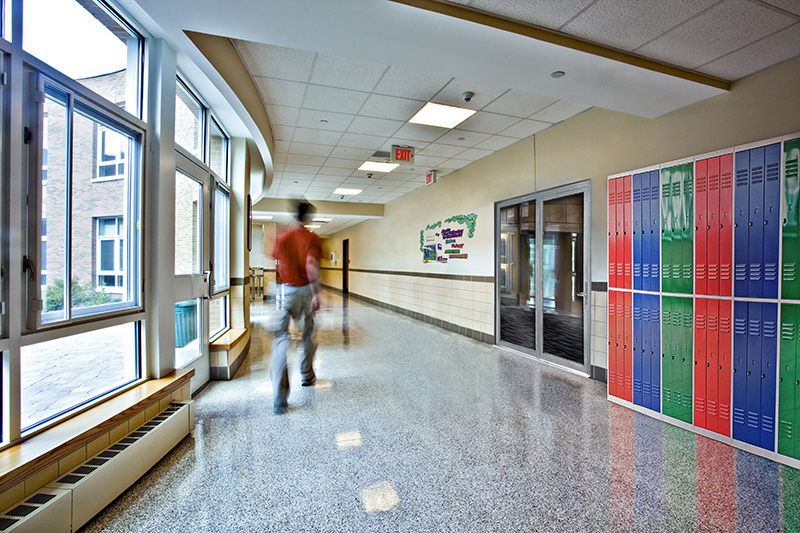Invisible Protection: Hardening Entrances with Multifunctional, Fire-Rated Glass
Balancing functionality and aesthetics

Along with establishing a school’s identity, a growing number of entryways have a responsibility: to provide a layer of protection against fire and life safety threats. Entrances can safeguard in many ways. They create a physical barrier while providing open sightlines across school grounds, which can give students and faculty more time to prepare and alert authorities if a violent intruder is spotted on campus. Building codes may also require these systems to be fire-rated to ensure safe passage during a fire event.
When wellbeing needs intersect, designing entryways with aesthetics and functionality can seem like a delicate balancing act.
For example, specifying steel doors with no glazing may satisfy safety and security goals, but their institutional appearance could work against occupant comfort. On the other hand, using non-rated glazing may contribute to a more welcoming environment but it could be prohibited by code and lessen the ability for entrances to resist attacks, a key point of contention in recent news.
However, multifunctional fire-rated glazing systems now make it easier for designers to meet many school-safety needs without having to compromise on aesthetics. These offerings deliver around-the-clock defense against fire while mitigating other safety and security threats, making them ideal for hardening entryways in schools and beyond.
Hardening entrances without compromising fire safety
The Partner Alliance for Safer Schools (PASS) K-12 guidelines recommend hardening a building’s perimeter as a part of a multilayered approach to school safety. This resource isolates different aspects of each layer and uses four tiers to categorize different levels of building perimeter security.
For glazing, these guidelines focus on two security measures: security films and ballistic-rated glass. Security films fulfill the lowest levels of safer school design while ballistic-rated glazing meets the highest. However, both security measures may complicate specifying a system where codes also require fire-rated materials. Many forced-entry and ballistic products are plastic-based, so they may burn quickly and intensely during a fire, creating situations that exceed testing standards. This, in turn, could reduce the amount of fire protection or resistance provided.
Given that the National Fire Protection Association (NFPA) states there are on average over 3,000 fires on school grounds each year, this is a particularly crucial consideration. As security becomes a more important facet of design, multifunctional, fire-rated glazing can help ensure one form of protection is not compromised for another.
Multifunctional, fire-rated glazing meets security and design challenges
To guard against multiple life safety threats (such as fire and forced-entry), multifunctional, fire-rated glazing is essential. That said, it is important that these assemblies either incorporate compatible components or are tested across multiple protocols.
Multifunctional, fire-rated glazing assemblies made from compatible components can meet requisite fire and life safety codes. Further, they can also withstand physical attacks while enhancing the effectiveness of other safety and security measures.
In addition to entrances, multifunctional, fire-rated glazing can be specified throughout a building to help keep occupants safe should a fire alarm go off during a lockdown. False alarms can happen as a tactic or as a result of gunfire. As such, providing multiple forms of protection can help keep occupants safe should lockdown and evacuation protocols overlap.
A word on model building codes
It is important to note that current model codes do not require entrance hardening for schools—project owners who wish to improve security in this way often do so voluntarily. Not only does this create a security disparity between school districts, but it also complicates specifying systems that meet or exceed security goals and fire code requirements. It is important, then, that, in addition to issuing best-practice guidelines, the building industry examines how model codes can be developed to address concerns about student safety and security.


